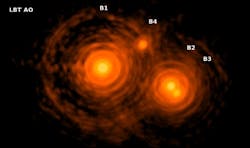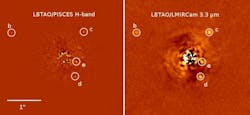Astronomers unveil first Large Binocular Telescope findings
| Four young stars in the Orion Trapezium cluster 1,350 light-years away are imaged by the LBT. This is the best image ever taken of these stars, which are all tightly located within 1 arcsecond of each other. By comparing this 2.16 micron infrared image to past images of this group over the last 15 years, astronomers can now see the motion of each star with respect to the others. The movements show that the stars in the mini-cluster were born together but will likely disperse as the stars age and interact with each other. (Image: LBT Observatory) |
The HR8799 planetary system is seen in two different IR wavelengths -- on the left, in the H band (1.65 microns); and on the right, in a narrow band centered on 3.3 microns which is sensitive to absorption by methane. All four planets are visible. This is the first time the innermost planet, HR8799e, has been imaged at either wavelength. The scale line spans 1 arcsecond. (Image: LBT Observatory) Source: http://www.lbto.org/Large%20Binocular%20Telescope%20brings%20the%20Universe%20into%20Sharper%20Focus.htm

